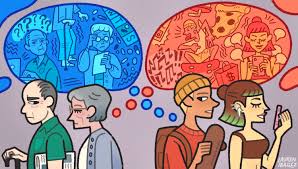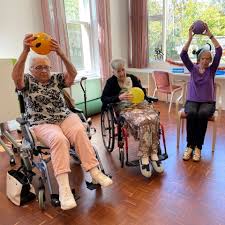6
Section One: The Fundamentals
A) Keywords
Exercise 1:
Provide a brief definition of one of the padlet keywords for this week.
| Equity
My definition of Equity refers to fairness and justice in the world including resources, opportunities, and treatment. It involves ensuring that everyone has equal access to the same opportunities and benefits, while also addressing any imbalances or disadvantages that may exist amongst certain groups of people.
|
B) The Social Significance of Aging in Sport
Exercise 2: Notebook Prompt
How is old age popularly represented today? Find an image online that you think exemplifies one defining attitude towards old age and paste in your notebook below with a brief explanation of what this image means to you.
| This image highlights how media and young people representations often depict older adults roles of diminished capabilities. These portrayals can contribute to societal beliefs of ageism such as that aging is synonymous with decline. Ultimately I think this is affecting how older individuals are perceived and treated. Although there are some pieces of media now suggesting an antiageism approach, More commonly that not I see images similar to this photo ive chosen.
|

Exercise 3: Notebook Prompt
What does the article (referencing another study by Dionigi) mean by its statement that sport can help aging people to simultaneously “accept and resist the ageing process” (572)? Respond by audio or text and find paste two images sourced online into your notebook showing how sport might help aging people to both accept and resist the aging process.
| The statement “sport can help aging people to simultaneously ‘accept and resist the aging process'” refers to the dual role that sport plays in the lives of adults and societies view of ageism on sport. On one hand, it can help people to accept the aging process by promoting awareness of their current physical and mental capabilities within sports. Furthermore, this means that sport encourages aging individuals to embrace their physical limitations therefore adjusting their expectations accordingly. On the other hand, sport can also help people resist aging and societal expectations of aging through physical fitness, such as through sport. Exercise promotes physical health, counteracting some of the natural declines such as strength, mobility, and endurance. |
Resisting aging in sport

Embracing aging in sport

Exercise 4: Notebook Prompt
Who are the groups less likely to have extensive opportunities to take part in sports, according to Pike? How does privilege factor into aging and sport? (200 words max)
| **I cant seem to access Pike’s Article so Ive answered this prompt with my own thoughts and ideas as best I could ! **
I would imagine that certain groups of people have significantly more opportunity to access sport especially high level and extensive opportunities through sport. For example people who experience certain social determinants such as people who are low income, people housing or job insecurity, people with disabilities (as discussed in earlier chapters), people with minorities such as gender, ethnic and cultural. Ultimately, these challenges can limit these groups of peoples access to sports facilities, programs, and resources (equipment, travel, ..) to engage in physical activities. Consequently, the privilege associated with financial stability, social status, and cultural inclusion plays a major role in determining who has the opportunity to fully participate in and benefit from sports, both recreationally and professionally. |
Exercise 5: Padlet Discussion
Why do you think age discrimination is “reported more than any form of prejudice” with older people presented as a threat to social values and interests? Feel welcome to use video in your responses. Paste your comments (or transcript of your video) below!
|
I think that Age discrimination is most often reported over other forms of prejudice due to society tending to hold fear towards aging, and seeing it as something negative. Older people are often viewed as a threat to social values due to stereotypes of aging aligning with weakness, decline, and financial burden. As the aging population is growing, society struggles to accommodate space in nursing homes, and healthcare, causing prejudice thought process. These worries are made worse by a culture that holds values in youth, and cognitively, which leads to further marginalization of older individuals. I believe this combination of fear and biases contributes to the disproportionate reporting of age discrimination.
|
B) Older Women and Sport
Exercise 6: Notebook Prompt
What differences do you see in these ads? Which one is more inclusive? How is age represented or not represented in each? Answer these questions in your notebook.
| Th first add “nike- you cant stop us (2020)” demonstrates empowering people in sport across diverse backgrounds including able bodies people and people with disabilities, male and females, people with different ethnicities and cultures, and so on. While the second video “This girl can- Me again” has a larger focus on empowering women in sport, including women who are menstruating, women with children, women of different ages, and so on. I believe both ads have significance and important messages associated with them, however I think the fist video “nike- you cant stop us (2020)” targets a larger diverse group of people, and is therefore a more inclusive ad. Both videos represent different age groups in sport, however, “This girl can- Me again” specifically addresses the population of older adults, while “nike- you cant stop us (2020)” includes people appearing to be youth- middle aged.
|
Exercise 7: Notebook Prompt
In her article, “Assessing the sociology of sport: On age and ability,” Elizabeth Pike references a “trend towards a ‘feminisation of ageing’, with many women living longer than men” (573). Do you agree that aging has been “feminized” in this way? How? Answer these questions in your notebook.
| **I cant seem to access Pike’s Article so Ive answered this prompt with my own thoughts and ideas as best I could wiht the information provided ! **
I agree with Elizabeth Pike’s idea that aging has been “feminized,”. For example,especially as women tend to live longer than men and this trend is reflected in society ad Women are more likely to face age-related challenges and have higher rates of chronic illness, yet they also experience the societal pressures of maintaining beauty as they grow older. I work in healthcare and am often emersed in an environment of older and aging adults, and can clearly see the expectation for women to get up and look “pretty” for breakfast, and men do not often have the same expectations. Its expected for men to become angry and violent whereas if women exude this behavior it is just inappropriate. The “feminization” of aging also highlights the dominant role women often play in family caregiving, making their aging experiences more visible when they are unable to keep up with this role. |
Section Three: Module Mini Assignment
|
** Again, I cant seem to access Pike’s Article.. so Ive answered this prompt as best I could! **
1)
The article provides a detailed look at a controversial proposal to replace the green spaces of Bonnerworth Park in Peterborough, Ontario, with more developed recreational facilities, including pickleball courts and bike trails that would add much concrete to the green space. While the discussion is largely about the park’s transformation in regards to heat, noise and community, it also highlights a broader issue related to the rise of pickleball and its appeal to older adults.
Pickleball is a sport that has been increasingly popular amongst older adults due to its relatively low-impact nature and accessibility. However, in cases like this one, its popularity also brings about concerns, particularly when it comes to the repurposing of public parks and green spaces. The debate within this article is not just about pickleball itself, but about the balance between catering to a growing demographic—older adults who enjoy the sport—and maintaining the broad, environmental benefits of green spaces in urban areas as well. However, it is also argued that Peterborough has plenty of green space currently, and therefore why are we not willing to cater to this populations wants and needs for sport, as we do for other groups?
2) In regard to the Bonnerworth Park pickleball issue, media seems to often depict older aged pickleball players as active, and enthusiastic participants in a sport that promotes health and well-being. They are portrayed as taking charge of their free time and adopting an active lifestyle. This is positive and challenges the stereotype that aging people are declining or inactive. However, I think ageism is evident still, especially in how the needs of older athletes are presented. For example, older adults would likely be benefiting from pickleball courts, however, this might be overlooked by a younger population of park users as they want to enjoy different types of recreation in their community park. Older advocates are sometimes seen as disruptive, or less worthy of pushing for changes that benefit them. This can subtly create divisions within sport based on age, where the older generation’s desires are seen as causing inconvenience. Finally, the neoliberal agenda around aging and sport, particularly in the case of pickleball, focuses on the idea that older adults should remain active and productive to minimize their otherwise expected decline that would cause them to be reliance on social services and healthcare. By promoting pickleball as a way for older individuals to stay active and maintain social status, it shifts the responsibility for health and well-being onto the individuals responsibility. This reflects a broader neoliberal belief that individuals are responsible for their own health and well-being, and that older people should stay self-sufficient and maintain youth like attitudes, rather than eventually becoming passive and relying on society, which is a part natural aging process.
|
|
|

